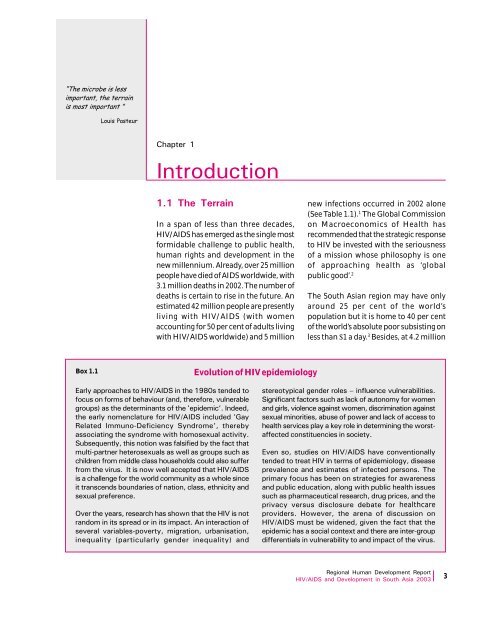Download Report - UNDP Asia-Pacific Regional Centre - United ...
Download Report - UNDP Asia-Pacific Regional Centre - United ...
Download Report - UNDP Asia-Pacific Regional Centre - United ...
You also want an ePaper? Increase the reach of your titles
YUMPU automatically turns print PDFs into web optimized ePapers that Google loves.
Introduction“The microbe is lessimportant, the terrainis most important ”Louis PasteurChapter 1Introduction1.1 The TerrainIn a span of less than three decades,HIV/AIDS has emerged as the single mostformidable challenge to public health,human rights and development in thenew millennium. Already, over 25 millionpeople have died of AIDS worldwide, with3.1 million deaths in 2002. The number ofdeaths is certain to rise in the future. Anestimated 42 million people are presentlyliving with HIV/AIDS (with womenaccounting for 50 per cent of adults livingwith HIV/AIDS worldwide) and 5 millionnew infections occurred in 2002 alone(See Table 1.1). 1 The Global Commissionon Macroeconomics of Health hasrecommended that the strategic responseto HIV be invested with the seriousnessof a mission whose philosophy is oneof approaching health as ‘globalpublic good’. 2The South <strong>Asia</strong>n region may have onlyaround 25 per cent of the world’spopulation but it is home to 40 per centof the world’s absolute poor subsisting onless than $1 a day. 3 Besides, at 4.2 millionBox 1.1Evolution of HIV epidemiologyEarly approaches to HIV/AIDS in the 1980s tended tofocus on forms of behaviour (and, therefore, vulnerablegroups) as the determinants of the ‘epidemic’. Indeed,the early nomenclature for HIV/AIDS included ‘GayRelated Immuno-Deficiency Syndrome’, therebyassociating the syndrome with homosexual activity.Subsequently, this notion was falsified by the fact thatmulti-partner heterosexuals as well as groups such aschildren from middle class households could also sufferfrom the virus. It is now well accepted that HIV/AIDSis a challenge for the world community as a whole sinceit transcends boundaries of nation, class, ethnicity andsexual preference.Over the years, research has shown that the HIV is notrandom in its spread or in its impact. An interaction ofseveral variables-poverty, migration, urbanisation,inequality (particularly gender inequality) andstereotypical gender roles – influence vulnerabilities.Significant factors such as lack of autonomy for womenand girls, violence against women, discrimination againstsexual minorities, abuse of power and lack of access tohealth services play a key role in determining the worstaffectedconstituencies in society.Even so, studies on HIV/AIDS have conventionallytended to treat HIV in terms of epidemiology, diseaseprevalence and estimates of infected persons. Theprimary focus has been on strategies for awarenessand public education, along with public health issuessuch as pharmaceutical research, drug prices, and theprivacy versus disclosure debate for healthcareproviders. However, the arena of discussion onHIV/AIDS must be widened, given the fact that theepidemic has a social context and there are inter-groupdifferentials in vulnerability to and impact of the virus.<strong>Regional</strong> Human Development <strong>Report</strong>HIV/AIDS and Development in South <strong>Asia</strong> 2003 3
















